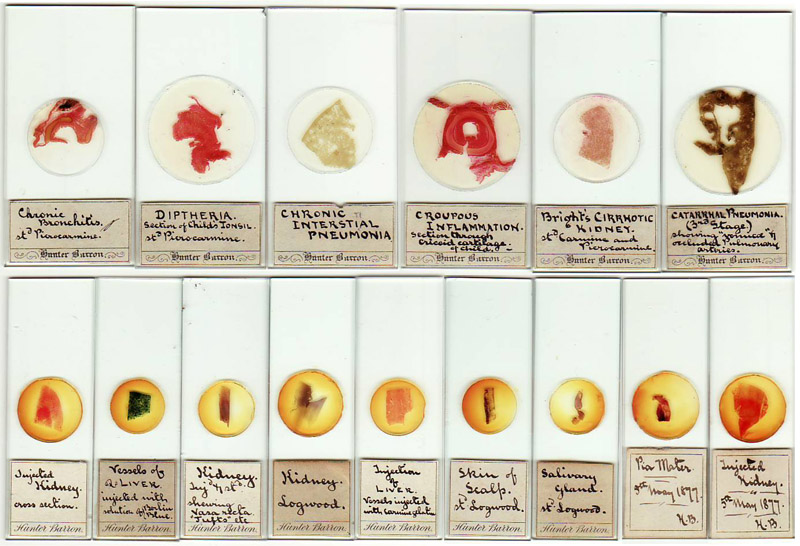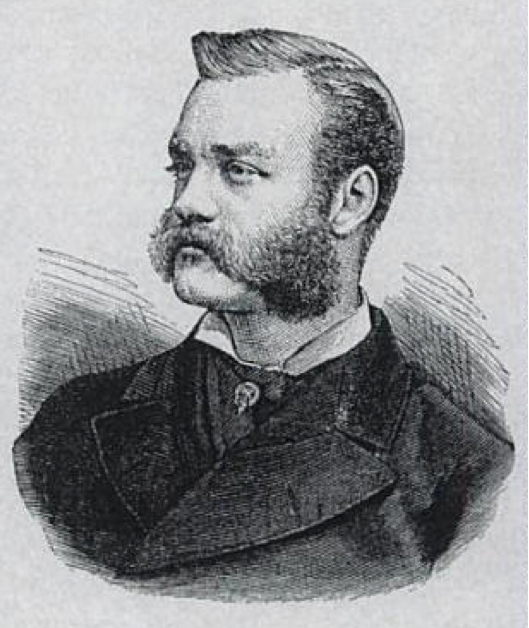Hunter Jackson Barron, 1857 – 1888
by Brian Stevenson
last updated August, 2010
Much can be learned from microscopic examination of healthy
and diseased tissues of humans and other animals. Histology has therefore been
an important part of medical education since the Victorian era. As a result of
100+ years of medical studies, there is now an abundance of amateurish slides
prepared by and for students, most of which are poorly made and of little value
to collectors. Less frequently, modern-day collectors will find high quality,
professional histology slides that were provided by experts such as A.C. Cole and/or retailed through microscopy supply houses such as Beck, Watson or Baker. Far
less common are expertly-made slides prepared by physicians, anatomists, etc.
for their own reference use. Rare indeed are those for which the maker can be
identified. These include microscope slides from Dr. Hunter J. Barron’s
collection (Figure 1). Barron was a notable physician, an expert on mollusks,
and quite famous as an early advocate of swimming for fitness.

Figure 1. Microscope slides made by Dr. Hunter J. Barron. The neatness of the finish and
use of personalized labels suggest that these were made for Barron’s personal
use as reference material. The upper row are 1 ½ by 3 inches in size, a
standard slide size for the time. The lower row are all 1 x 3 inches.
Hunter Jackson Barron was born March 31, 1857, apparently
the eldest child of Edward J. and Eliza Barron. Father Edward was a notable
London lawyer. Edward was also a significant member of the London and Middlesex Archaeological
Society, serving as Vice President and Council member for many years. Hunter
received his early education at the Charterhouse, one of the oldest private
schools in England.
Barron initially studied medicine at St.
Thomas's Hospital, and matriculated at the London University. Although he left
that school before completing his studies, Barron served as a steward at the St
Thomas’s Hospital Old Students’ Annual Dinner in 1885. Having decided that the
London course was “too protracted”, he
transferred to Edinburgh. Barron there received his M.B. (Bachelor of Medicine)
and C.M. (Magister Chirurgiae – Master of Surgery) degrees in 1883, and M.D.
(Doctor of Medicine) in 1885. He also received a Pattison Medal in medicine.
One of his obituary notices reported that Barron donated his own blood to a
patient when it became necessary during a surgery. After graduation, Barron
returned to the London area, establishing a practice in Finchley. He was
elected a Fellow of the Obstetrical Society of London in 1886.
In addition to his medical interests, Barron was a
keen student of zoology. While at Edinburgh, in 1879, he received the Sir
Wyville Thomson Silver Medal for Practical Zoology. He was elected a Fellow of
the Royal Physical Society of Edinburgh in 1880, and of the Linnaean Society in
1887. Barron formed an extensive collection of British mollusks, which was
donated to the Linnaean Society after his death. It was then presented to the
Mason Science College, Birmingham. He also contributed mollusk specimens to the
British Museum.
Swimming was one of Barron’s
greatest passions. His obituary in the Transactions of the Obstetrical Society of
London stated, “Dr. Barron was
distinguished in athletics as well as in science. He had been a good swimmer
from a very early age, and was well known in the swimming world as a firstrate
amateur in the art. He took very great interest in this pursuit, and did all
that he possibly could to encourage it. He had been captain of the Otter
Swimming Club (ed. note: in 1878. The Otters is one of the oldest swimming
clubs in England), and also hon.
secretary of the Swimming Association of Great Britain from 1880 to 1883, and
president in 1884 and 1885, doing much in both those capacities for the
encouragement of the art. On his resigning the position of president in 1886,
he was presented by the delegates of the Association with a handsome
testimonial, in appreciation of his efforts to promote
and popularise swimming generally. Portraits and memoirs of him as an amateur
swimmer appeared in the 'Bicycling and Athletic Journal' of November, 1880, and
the 'Sporting Mirror' of May, 1882, and he had from time to time contributed
articles on his favourite pastime to the 'Field ' and other papers. His love
for swimming as a sport was subordinate, however, to his desire to encourage it
as a health-giving, life-saving art, and he was never more pleased than when
lecturing to a school or institute on the subject, or framing rules for their
guidance in forming clubs”.
Barron was
clearly a healthy man in his youth. Modern
English Biography noted that he walked from London to Portsmouth, a
distance of 72 miles/116 kilometers, in only 23 hours on 9-10 August, 1879.
His obituary in the Transactions of the Obstetrical Society of
London reported that “Dr. Barron
suffered much mental anxiety in the year 1886”, with symptoms of diabetes
appearing during that autumn. However, “he
never deceived himself as to the result, but preferred to work on until the
end, rather than give up. As a matter of fact he visited patients two days
before his death, and the final end was due to his catching cold on his rounds.” Hunter Barron died on February 9, 1888, at the age of 31.

Figure 2. Hunter Jackson Barron. From the Bicycling and Athletic Journal, Nov. 4, 1880.
Acknowledgement
Many thanks to Maureen Carter for images of Hunter J. Barron’s microscope slides.
Resources
Alphabetical list of graduates of the University of Edinburgh from 1859
to 1888 (1889) page 20. The University of
Edinburgh.
Bicycling and Athletic
Journal (1880), Our Portraits: Mr. H.J. Barron, Nov. 4, page 19.
Reprinted in Mike Huggins (2004) The
Victorians and Sport, Continuum International Publishing Group, London.
The Lancet (1885)
St. Thomas’s Hospital Old Students’ Annual Dinner, Vol. 2, page 34, Sept. 26.
List of past officers of the Otters Swimming Club, accessed
through www.otterswimming.com/myotter/pastofficers-template.asp
Modern English Biography, Vol. 4, supplement Vol. 1,
A-C (1906) by
Frederic Boase, Netherton and Worth, Truro. Page 285.
Nature (1887)
report of the April 7 meeting of the Linnaean Society, Vol. 35, page 623.
Proceedings of the Linnaean
Society (1888) Obituary of Hunter Jackson Barron, Vol. 22, page 48
Proceedings of the Royal
Physical Society of Edinburgh (1880) report of the March
17,1880 meeting, Vol. 5, page 379.
Proceedings of the Royal
Physical Society of Edinburgh (1881) Vol. 6, page 293.
“Scrutator” (1880) Our contemporaries, The Lily, Vol. 1, page 83.
The Students’ Journal and
Hospital Gazette (1883) Pass list of the University of Edinburgh,
July 14, page 308.
Transactions of the London and Middlesex
Archaeological Society (1890) List of Officers, Vol. 6, and other issues of this journal.
Transactions of the Obstetrical Society of London (1886) report of the October 6, 1886 meeting, Vol. 27, page 15.
Transactions of the Obstetrical Society of London (1889) Annual address, Vol. 32, pages 90-91.
Vital statistics of England, accessed through ancestry.co.uk
Vital statistics of Scotland, accessed through
scotlandspeople.gov.uk

